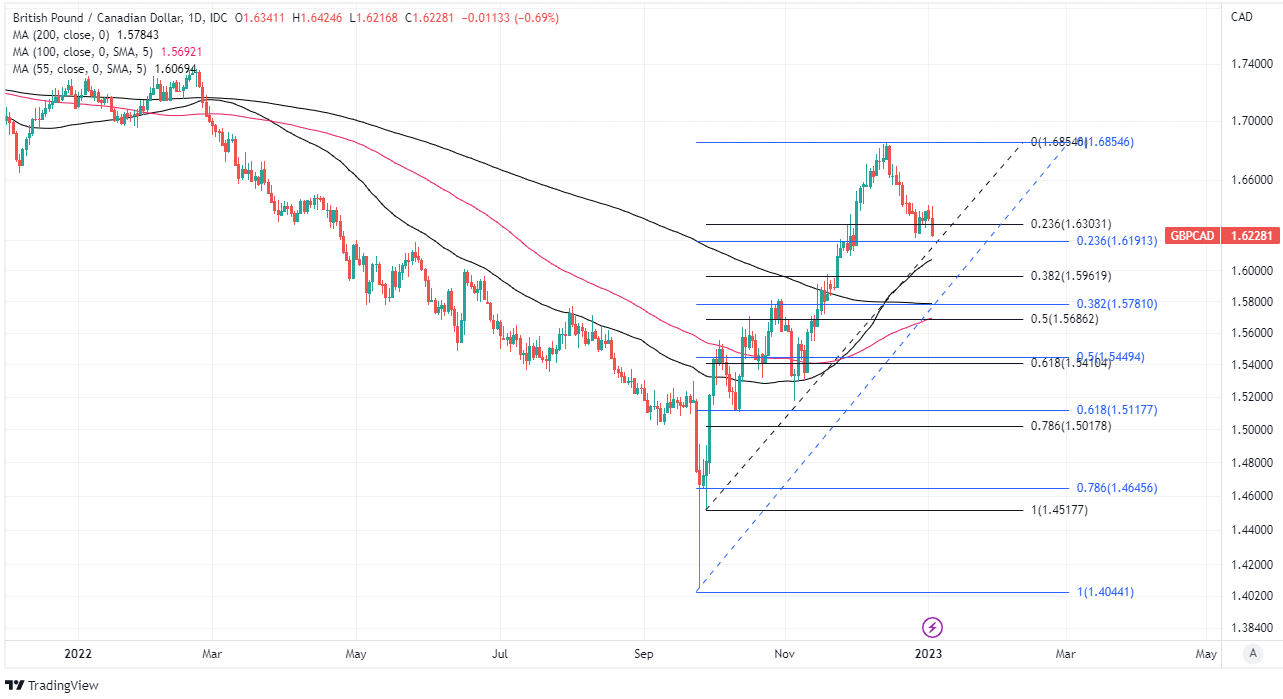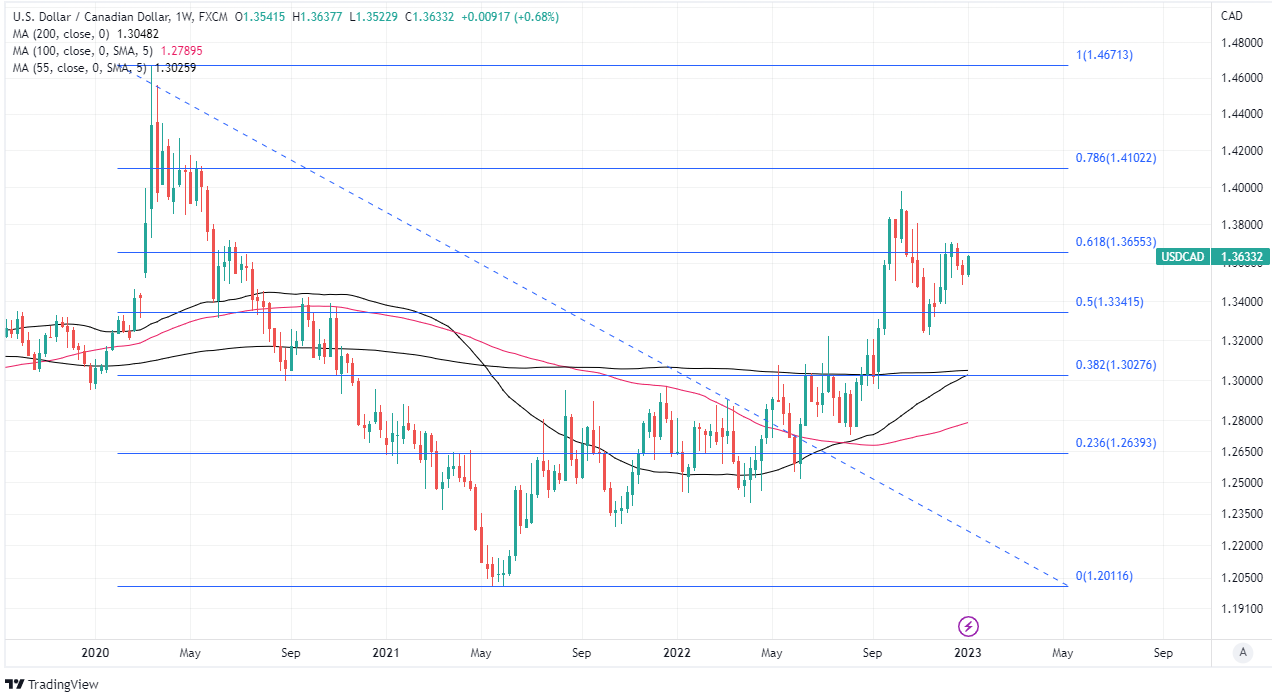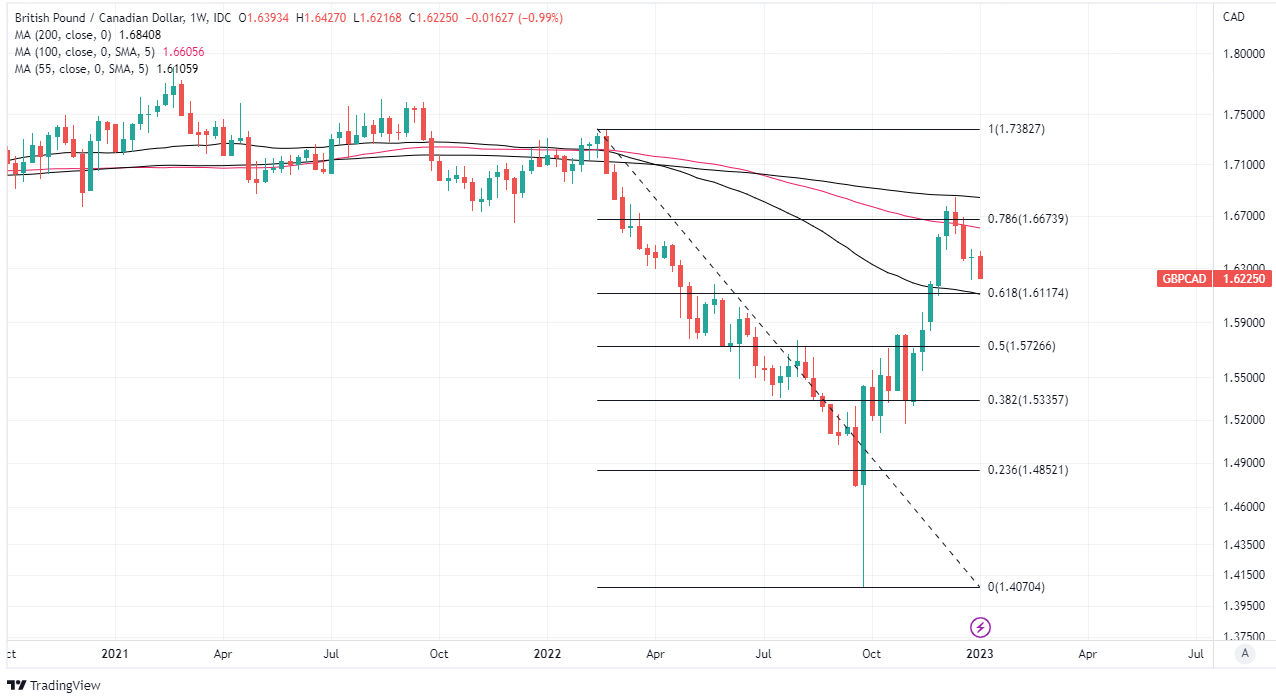GBP/CAD Week Ahead Forecast: Supported Above 'Fair Value'
- Written by: James Skinner
-
- GBP/CAD fairly valued between 1.5980 and 1.6160 short-term
- But risk of GBP/CAD remaining buoyant above 1.62 for now
- USD/CAD fairly priced at 1.2784 but 1.33-1.3692 range likely
- North American payrolls & global risk appetite key short-term

Image © Pound Sterling Live
The Pound to Canadian Dollar exchange rate tumbled into the New Year amid a sharp rally by North American currencies and may be most likely to trade between 1.5980 and just above 1.62 over the coming days.
North American currencies from a directionless slumber to open the first full European trading session of the year with strong gains that pushed the Pound to Canadian Dollar pair back near to the round number of 1.62 on Tuesday.
"As 2023 begins there is an increasing sense of normalisation within currency flows," says Charles Porter, a market commentator at London-based international payments specialist SGM Foreign Exchange.
While trading activity was normalising on Tuesday, the author's rudimentary calculations suggest that Pound Sterling was still more than fairly valued against the Canadian Dollar even at its newly-reduced levels.
Using the latest inflation and cash rate differentials to deflate from a January 2022 starting level around 1.7020 suggests that a fair short-term value for GBP/CAD would be somewhere between the 1.5980 and 1.6160 levels.
 Above: Pound to Canadian Dollar rate shown at daily intervals with Fibonacci retracements of late September recovery indicating possible areas of technical support for Sterling. Click image for closer inspection.
Above: Pound to Canadian Dollar rate shown at daily intervals with Fibonacci retracements of late September recovery indicating possible areas of technical support for Sterling. Click image for closer inspection.
The same above-referenced process suggests that USD/CAD is currently overvalued and that a more appropriate level for it would be around 1.2784.
"We still see the CAD as undervalued on the crosses and like playing that view via EUR/CAD and GBP/CAD downside for now," says Bipan Rai, North American head of FX strategy at CIBC Capital Markets.
The author's own financial model, however, suggests that GBP/CAD is likely to remain supported a short distance above the round number of 1.62 and that USD/CAD is likely to trade between 1.33 and 1.3692 this week.
The model uses a process of cross-currency triangulation and currencies' latest sensitivities to the U.S. Dollar to estimate where non-Dollar exchange rates would be likely to trade as the U.S. Dollar itself rises and falls.
"The mapping between USDCAD and broad USD indexes was fairly tight through most of 2022. That mapping has fallen apart over the past few weeks due to the shocking decline in the price of Western Canada Select crude," says Greg Anderson, global head of FX strategy at BMO Capital Markets.
"As of today, we would pen in 1.35 as our 3M or end-of-Q1 point forecast for USDCAD. We think the Q1 range is likely to be roughly 1.33 to 1.38. We would be looking for mean reversion trades in the pair along the edges of that range," Anderson writes in a December 22 research briefing.
 Above: USD/CAD at weekly intervals with Fibonacci retracements of 2020 downtrend indicating possible technical resistances. If you are looking to protect or boost your international payment budget you could consider securing today's rate for use in the future, or set an order for your ideal rate when it is achieved, more information can be found here.
Above: USD/CAD at weekly intervals with Fibonacci retracements of 2020 downtrend indicating possible technical resistances. If you are looking to protect or boost your international payment budget you could consider securing today's rate for use in the future, or set an order for your ideal rate when it is achieved, more information can be found here.
While the Canadian Dollar appears undervalued against both Sterling and the U.S. Dollar, a full correction of such a mispricing might be unlikely in the short-term if this week's data continues to cast the U.S. economy in a more resilient light than its Canadian counterpart.
This is one reason why Friday's release of December employment figures from the U.S. and Canada are likely to be scrutinised closely with any signs of a faltering labour market potentially encouraging speculation about the prospect of an imminent end to the Bank of Canada (BoC) interest rate cycle.
"There have been early signs of softening in the outlook and we look for the Canadian unemployment rate to tick up to 5.2% on a soft 5k increase in employment," says Adam Cole, chief FX strategist at RBC Capital Markets.
"The unemployment rate has ticked up from the record low (dating back to at least 1976) 4.9% earlier in the summer but is still well-below pre-pandemic levels. As a result of tight labour market conditions, wage growth has been accelerating," Cole writes in a Monday research briefing.
Much will also depend, however, on whether U.S. demand for new employees remains as robust as it has in recent months because this could discourage interest rate markets from doubting whether the Federal Reserve will be able to lift its interest rates as far as December's forecasts suggested likely.
 Above: Pound to Canadian Dollar rate shown at weekly intervals with Fibonacci retracements of 2022 downtrend indicating possible areas of technical resistance for Sterling. Click image for closer inspection. To optimise the timing of international payments you could consider setting a free FX rate alert here.
Above: Pound to Canadian Dollar rate shown at weekly intervals with Fibonacci retracements of 2022 downtrend indicating possible areas of technical resistance for Sterling. Click image for closer inspection. To optimise the timing of international payments you could consider setting a free FX rate alert here.
"Going into the end of last year, the Fed slowed the pace of tightening despite a tight labor market and very elevated wage growth. A slower pace of tightening led to an easing in financial conditions," writes Sid Bushan, an economist at Goldman Sachs, in a Tuesday research briefing.
"However, now that much of the slower pace has already been priced in, the market reaction to data surprises could soon become more symmetric and this week’s labor market data (job openings on Wednesday, payrolls on Friday) could be the first test of that in the new year," he adds.
Meanwhile, however, the Canadian Dollar and other commodity-linked currencies could benefit to the detriment of Sterling from financial market optimism about the global economy following China's abandonment of attempts to contain the coronavirus.
"China’s economy will bear short-term pain for long-term gain as the government has made an abrupt exit from zero Covid. The economic recovery will likely begin in Q2, or even as soon as March, much earlier than previously expected," says Tommy Wu, an analyst at Commerzbank.
"The abrupt U-turn of Covid policy, which is uncharacteristic of the Chinese government, poses an upside risk to our 2023 growth forecast which is currently at 4%," Wu and colleagues write in a Tuesday market commentary.











